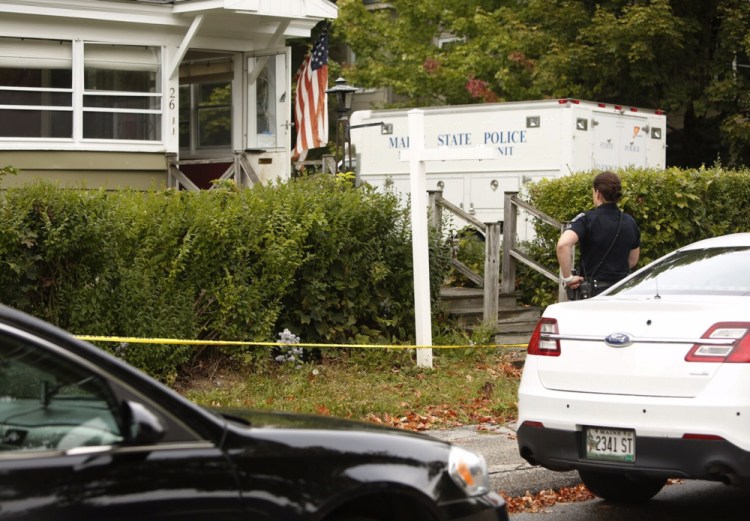The family of a Rochester, New Hampshire, man killed last year in Saco doubts the police conclusion that he was shot in self-defense and is calling on investigators to revisit the case.
The call for more scrutiny comes after Maine State Police investigators last week said they had determined the shooting death of Michael Burns, 54, was not a crime. The Maine Attorney General’s Office, which prosecutes homicides and manslaughter cases, declined to prosecute Burns’ killer.
The investigation lasted nearly a year. Police said Burns was armed with a knife when he was shot three times, including once in the head.
Police have not identified the person who shot Burns, but the owner of the property where the shooting happened identified him as Christopher Boure, 43, who rents the first-floor apartment at the house.
In a statement, an attorney for Burns’ estate who was hired by the family this week after a Portland Press Herald report about the police conclusion, cited several factors that the family believes contradict the official conclusion, which relied on details provided by Boure and other people interviewed.
In response to questions about the statement, state police said they have not received a copy directly, but were provided one by the media.
“We have investigated the case for almost a year and arrived at the conclusions that we talked about earlier,” said Steve McCausland, spokesman for the Maine Department of Public Safety. “I have no reaction to their request.”
The family is considering legal action against Boure and two other unnamed people who were allegedly at the home before Burns was killed.
According to police, Burns went to the home at 26 Nye St. on Sept. 30, 2017, looking to pay for sex after answering a Craigslist advertisement. Police say he was robbed inside, went to his truck and returned to the house armed with a knife. McCausland said Burns got into a confrontation on the porch and was shot in self-defense by a resident, whom police declined to name.
“What the family is really looking for are answers and justice,” Alfred T. Catalfo III, the Dover, New Hampshire, attorney now representing the Burns estate, said in a telephone interview. “This is a guy who was really an upstanding member of the community. And we all know that doesn’t necessarily mean certain things didn’t happen. But him going on a violent rampage and being killed in self-defense is really, really hard to believe.”
Family members were puzzled by the death of Burns, who was an Army veteran, devoted father, and an active Boy Scout troop leader.
Catalfo’s theory is that Burns never left the home and was robbed and killed there.
The statement by Catalfo also provides new details of what police believe occurred that night, which were relayed to Burns’ family members by investigators at the conclusion of the investigation.
According to Catalfo, police believe that Burns drove from Rochester to meet a woman at the Nye Street home. When he arrived, Burns was met by a woman and taken into a home where he paid her $100. But the two did not have sexual contact, and soon a man, who was not the gunman, entered the room and told Burns to leave.
Burns left the home without physical confrontation, but may have made verbal threats, according to the family’s attorney.
The man who told Burns to leave also left the home at the same time. Burns then went to his truck and retrieved a pocket knife, a bag of tools that did not contain any weapons and a 5-gallon bucket of “pull cord,” which is used for fishing computer network wires through walls, a part of Burns’ job.
When Burns returned to the home, he was met for the first time by the gunman on the front lawn. The man had just returned from a convenience store to buy alcohol, according to Catalfo.
“Mr. Burns allegedly told the man he was going to kill him and burn the house down,” Catalfo wrote. “There are no witnesses to this other than the shooter, who is claiming self-defense.”
Catalfo said the gunman then retreated through an enclosed front porch and into the residence, but Burns followed him into the porch, leaving his tools and bucket of pull cord outside.
The gunman closed the front door between the house and the porch, but Burns fought through the door using his pocket knife. From this scuffle, the gunman is said to have suffered a single cut on his arm from the knife, according to Catalfo.
Catalfo said Burns followed the gunman down a hallway near the back of the building, where Burns was ultimately shot three times, twice in the chest and once in the head. The rounds were fired from between 1 foot and 3 feet away.
“We respectfully but strongly take issue with this official story,” Catalfo wrote.
Catalfo said Burns was shot in the back of the head, which does not indicate self-defense. Catalfo also argued that Burns, who was 5-foot-10 and weighed 250 pounds, would not have needed a pocket knife to re-enter the home. Police also told the family that there were no signs of forced entry at the doorway, he said.
The recent details released to the family do not explain why investigators initially said publicly that Burns was killed on the front porch. An evidence envelope that contained Burns’ wallet said the wallet was found on a stairway leading to the building’s second floor, which does not seem to square with the official story, according to Catalfo.
“As Mr. Burns is deceased, the entire official story is supported only by the accounts of the shooter, the man who robbed Mr. Burns, and his associate, the woman who met Mr. Burns when he arrived.”
Catalfo said the man who robbed Burns is a “convict and parolee,” but Catalfo did not identify that man. Catalfo said the man who robbed Burns was also found hiding under a bed when police arrived.
“It is inexplicable as to why, after robbing Mr. Burns, this man would leave the premises and then come back after Mr. Burns was killed,” Catalfo said in the statement.
Matt Byrne can be contacted at 791-6303 or at:
Comments are not available on this story.
Send questions/comments to the editors.





